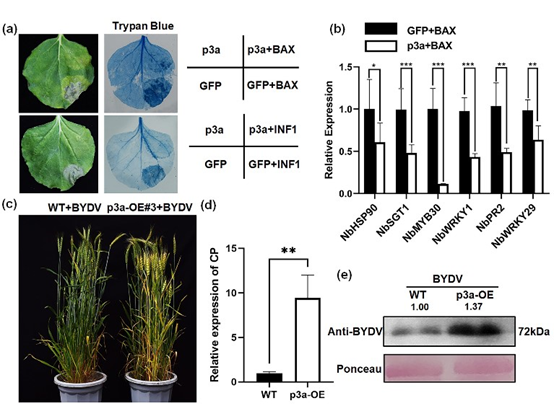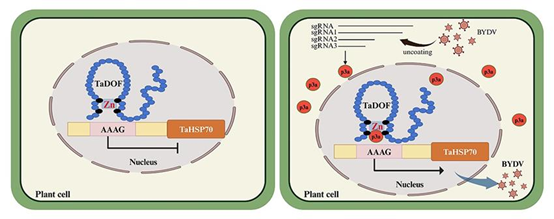Plant Viruses and Viral Genetic Engineering Technology Specializing Research Team from our college has published an online research paper titled "A viral p3a protein targets and inhibits TaDOF transcription factors to promote the expression of susceptibility genes and facilitate viral infection" in the journal PLOS Pathogens. This paper reveals the function and mechanism of action of the Barley Yellow Dwarf Virus (BYDV) p3a protein during BYDV infection of wheat. Drs. Tian Shuyuan and Song Qingting from our college are the co-first authors of this paper, while Professors Wu Yunfeng and Zhao Lei are the co-corresponding authors.
Wheat yellow dwarf disease caused by BYDV is a significant disease affecting wheat-growing regions in northwest, north, and Huang-Huai areas of China. Typically, autumn wheat seedlings infected with the disease quickly spread via aphid migration, causing wheat to yellow and dwarf, leading to reduced yields or even crop failures. This disease is known as the "cancer" of wheat crops. However, research on the pathogenic mechanism of BYDV has been at a preliminary stage, especially regarding the function and mechanism of action of the BYDV p3a protein.By transiently co-expressing p3a with BAX and INF1 in Nicotiana benthamiana, it was found that p3a has the ability to inhibit tobacco cell necrosis induced by BAX and INF1. Viral quantification results showed that transient overexpression of the p3a protein in wheat promoted the accumulation of BYDV. Various methods, including yeast two-hybrid screening, pull-down validation, bimolecular fluorescence complementation, and co-immunoprecipitation, demonstrated that the transcription factor TaDOF interacts with p3a, and the interaction occurs in the nucleus. TaDOF can induce reactive oxygen species (ROS) bursts in the nucleus, cell membrane, and chloroplasts, while the expression of p3a inhibits TaDOF-induced ROS bursts.

The function of the p3a protein in inhibiting tobacco cell necrosis and promoting BYDV infection
The zinc finger domain of the TaDOF transcription factor interacts with the TaHSP70 promoter to inhibit the expression of TaHSP70. When BYDV infects wheat, the BYDV p3a protein binds to the zinc finger domain of the wheat TaDOF transcription factor, inhibiting the function of TaDOF, thereby relieving the inhibition of the TaHSP70 promoter by TaDOF and increasing the expression level of TaHSP70. Increased expression of TaHSP70 facilitates BYDV infection. The amino acids at positions 32-48 of p3a are critical for its immunosuppressive function, and amino acids at positions 34 and 40 of p3a are key sites for its interaction with TaDOF. When amino acids at positions 34 or 40 of p3a are mutated, the nuclear import of p3a is significantly reduced. This study is of great significance for revealing the interaction mechanism between BYDV and wheat.

A schematic diagram of the mechanism by which the p3a protein promotes BYDV infection
This research was funded by the National Natural Science Foundation of China and other projects.
Original link: https://doi.org/10.1371/journal.ppat.1012680